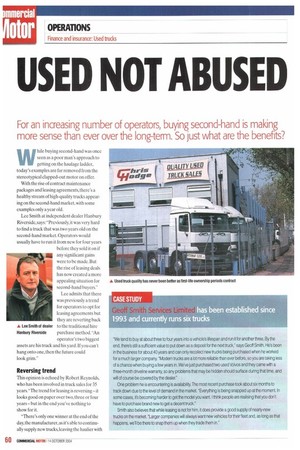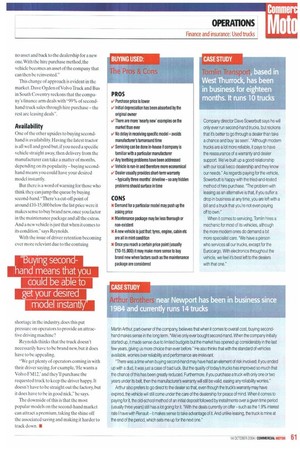USED NOT ABUSED
Page 62

Page 63

If you've noticed an error in this article please click here to report it so we can fix it.
For an increasing number of operators, buying second-hand is making more sense than ever over the long-term. So just what are the benefits?
While buying second-hand was once seen as a poor man's approach to getting on the haulage ladder, today's examples are far removed from the stereotypical clapped-out motor on offer.
With the rise of contract maintenance packages and leasing agreements, there's a healthy stream of high-quality trucks appearing on the second-hand market, with some examples only a year old.
Lee Smith at independent dealer Hanbury Riverside, says: "Previously, it was very hard to find a truck that was two years old on the second-hand market. Operators would usually have to run it from new for four years before they sold it on if any significant gains were to be made. B ut the rise of leasing deals has now created a more appealing situation for second-hand buyers," Lee admits that there was previously a trend for operators to opt for leasing agreements but they are reverting back 41 Lee Smith of dealer to the traditional hire Hanbuty Riverside purchase method. An operator's two biggest assets are his truck and his yard. If you can't hang onto one, then the future could look grim."
Reversing trend This opinion is echoed by Robert Reynolds, who has been involved in truck sales for 35 years. "The trend for leasing is reversing—it looks good on paper over two, three or four years— but in the end you've nothing to show for it.
"There's only one winner at the end of the day, the manufacturer, as it's able to continually supply new trucks, leaving the haulier with no asset and back to the dealership for a new one. With the hire purchase method, the vehicle becomes an asset of the company that can then be reinvested."
This change of approach is evident in the market. Dave Ogden of VolvoTruck and Bus in South Coventry reckons that the company's finance arm deals with "99% of secondhand truck sales through hire purchase the rest are leasing deals".
Availability
One of the other upsides to buying secondhand is availability. Having the latest tractor is all well and good but, if you need a specific vehicle straight away, then delivery from the manufacturer can take a matter of months, depending on its popularitybuying secondhand means you could have your desired model instantly.
But there is a word of warning for those who think they can jump the queue by buying second-hand."There's a cut-off point of around £10-15,000 below the list price were it makes sense to buy brand new, once you factor in the maintenance package and all the extras. And a new vehicle is just that when it comes to its condition," says Reynolds.
With the issue of driver retention becoming ever more relevant due to the contuing shortage in the industry, does this put pressure on operators to provide an attractive driving machine?
Reynolds thinks that the truck doesn't necessarily have to be brand new, but it does have to be appealing.
"We get plenty of operators coming in with their driver saying. for example,'He wants a Volvo FM12; and they'll purchase the requested truck to keep the driver happy. It doesn't have to be straight out the factory, but it does have to be in good nick," he says.
The downside of this is that the most popular models on the second-hand market can attract a premium, taking the shine off the associated saving and making it harder to track down.


































































































































































































